INTRODUCTION
Potato (Solanum tuberosum L.) is one of the most important cultivated species globally (Sebnie et al., 2021), with the fourth position in production volume after maize, rice, and wheat (Yadav et al., 2022). In Colombia, the potato crop is the second-highest crop of importance on a national scale (Fedepapa, 2020). This crop is distinguished as a primary short-cycle cultivation, with production primarily concentrated in eight departments; notably, Boyaca emerges as the second-largest national contributor (Fedepapa, 2020; Torres-Hernández et al., 2020).
Crop mineral nutrition is a major concern for growers (Güiza-Castillo et al., 2020), as it plays a fundamental role in achieving crops with high productivity (Rengel et al., 2023). Fertilization with these elements can only be successful when all the nutrients required by the plant are available in sufficient quantities in the soil. Potato crop production is mainly located in soils that present problems of aluminum and/or manganese toxicity with low availability of essential elements, such as phosphorus (P), calcium (Ca), and magnesium (Mg), which is one of the most limiting problems in soil use in the tropics (Malagón, 2003). Recently, Castellanos et al. (2022) mention the importance of optimizing fertilization on potato crop with Ca, Mg and S.
For soil acidity correction, there are several materials on the market known as amendments that react in the soil and generate changes in pH and neutralization of exchangeable Al+3 (Gutiérrez and Restrepo, 2019; Torres-Hernández et al., 2020). Among the liming materials used as acidity correctives are mainly carbonates, oxides, hydroxides, silicates, and sulfates of Ca and/or Mg (Castro and Munevar, 2013), and complex amendments, which are the mixture of several liming materials that manage to correct the acidity complexes in surface and depth, allowing the contribution of elements such as phosphorus, calcium, magnesium, sulfur, and silicon (Bernal et al., 2016).
Currently, the high cost of agricultural inputs, along with the low response of crops to fertilization, has increased interest in the development of technologies and practices that improve agricultural efficiency and productivity (Hailu et al., 2017). Faced with this situation, the concept of non-conventional sources has gained strength, among which are fertilizer amendments. These are considered liming materials that provide phosphorus, calcium, magnesium, sulfur, and silicon.
They present intermediate solubility and/or reactivity that improves the availability of nutrients in both short and long terms, in assimilable forms throughout their phenological cycle (Torres-Hernández et al., 2020). They also allow adequate assimilation of the nutrients provided through fertilization plans, thanks to the neutralization and precipitation of exchangeable edaphic acidity as a limiting factor. Such benefits have been reported in crops such as beans (Pinzón et al., 2017; Quintana et al., 2017), strawberries (Galindo-López et al., 2018), and the potato 'Superior' (Torres-Hernández et al., 2020).
Due to the significance of this plant species and the necessity to generate information regarding the fertilizer contribution from various types of liming materials, the impact of increasing doses of different fertilizer amendments on the growth and yield parameters of the potato (Solanum tuberosum L.) crop, 'Diacol Capiro', was evaluated under agroecological conditions in the municipality of Soraca (Colombia).
MATERIALS AND METHODS
Location
The research was conducted in the municipality of Soraca (Colombia), specifically on the Guayacán farm in the locality "Otro Lado". The geographical coordinates of the location were 5°31'17.6" N and 73°19'44.2" W. The site was situated at an altitude of 2,809 m, with an average temperature of 13.2°C and an annual average rainfall of 810 mm. The study covered two productive cycles (Season 1 winter season from February to June and Season 2 dry season from August and January of 2022).
The selected site featured soil with acidity issues, high concentrations of exchangeable aluminum, and low availability of essential bases such as calcium (Ca), magnesium (Mg), and potassium (K). A modal profile was conducted by taxonomic characterization at the subgroup level (USDA, 2010) resulting a Typic distrustepts, alongside the determination of chemical and physical variables at the soil level (Tab. 1). This site was chosen within an area known for its high potato production.
Table 1. Physical-chemical analysis modal profile of experimental site.
| Horizon (cm) | pH | CO (%) | Ca | Mg | K | Na | CICE | AI | CE (dS m-1) | P | Fe | Mn | Zn | Cu | B | S |
|---|---|---|---|---|---|---|---|---|---|---|---|---|---|---|---|---|
| (meq 100 g-1) | (mg kg-1) | (meq 100 g-1) | ||||||||||||||
| Ap (0-21) | 4.5 | 0.9 | 2.4 | 1.4 | 0.4 | 0.1 | 6.9 | 2.7 | 0.4 | 27.4 | 88 | 4.7 | 2.5 | 1.8 | 0.6 | 10.2 |
| A2 (21-31) | 5.5 | 1.0 | 3.9 | 1.7 | 0.5 | 0.1 | 6.2 | 0 | 0.3 | 30.9 | 127 | 6.2 | 4.2 | 1.6 | 0.4 | 12.1 |
| Bw (31-47) | 6.1 | 2.6 | 8.6 | 1.5 | 0.3 | 1 | 11.4 | 0 | 0.4 | 51.0 | 192 | 8.4 | 4.4 | 2.3 | 0.8 | 14.7 |
For the study, the 'Diacol Capiro' potato (commonly referred to as R-12), was chosen as an indicator crop. This variety holds a prominent place due to its extensive cultivation within the country according to Ñústez et al. (2009). It possesses characteristics well-suited for the trial conditions and enjoys excellent acceptance in the industrial market.
Experimental design and agronomic management
Two evaluation cycles were conducted, with each one utilizing a completely randomized design (CRD). Each cycle comprised 10 treatments, consisting of different fertilizers amendments. These included: A thermal phosphate (P2O5 20%, CaO 28%, MgO 8.5%, SiO2 15%), produced at 1,600 °C and then subjected to a thermal shock in settling pools. This process generates high citrosolubility and high reactivity. A double silicate of calcium and magnesium (P2O5 3%, CaO 30%, MgO 13%, SiO2 20%). This was obtained by crushing, grinding, and screening rocks known as serpentines, along with white slag. A mixture Triple 30® Amendment (Rio Claro, Medellin) consisting of 30% calcium carbonate, 30% magnesium silicate, 30% calcium sulfate, and 10% phosphate rock (P2O5 3%, CaO 26%, MgO 12%, S 5%, SiO2 12%), was used. The doses applied for each amendment were 300, 600, and 900 kg ha-1. In the control treatment, no amendment was applied. The doses were based on previous studies (Pinzón et al., 2017; Quintana et al., 2017; Torres-Hernández et al., 2020). Additionally, a control treatment with no application was included. Each treatment was replicated four times, resulting in a total of 40 experimental units (EU). Each EU was composed of 15 m of linear furrows, with a plant spacing of 0.3 m and a distance of 0.8 m between furrows, equating to 50 plants per experimental unit.
The nutritional plan was tailored based on soil analysis and crop requirements (Guerrero-Riascos, 1995). Nutritional needs in terms of nitrogen, phosphorus, and potassium were adjusted using simple fertilizer sources such as urea, DAP, KCl, along with minor elements provided through B-Zn application (8% boron + 4% zinc). Pest and disease management followed a monitoring-based approach, utilizing protective and systemic products. The primary disease concern was Phytophthora infestans, which was effectively controlled through the application of chlorothalonil, dimethomorph, mancozeb, cymoxanil, and metalaxyl. Among the insect pests, Tecia solanivora posed the greatest limitation, and its population was managed using thiamethoxam, cyantraniliprole, and imidacloprid.
Water requirements were aligned with the allowed percentage of depletion based on the phenological stage of the potato plants, following the methodology outlined by Guerrero (2019). Irrigation was administered using a sprinkler system.
Variables evaluated
The quantification of dry and fresh mass accumulation in the root and aerial parts (stems + leaves), leaf area, and leaf thickness was conducted 120 d after planting. It's important to note that this time point represents the peak of vegetative growth for the evaluated variety (Valbuena et al., 2010) under the study conditions.
For the assessment of fresh mass, five complete plants were collected from the center of each experimental unit. These plants were then placed in paper bags with a capacity of 10 kg, appropriately labeled according to the treatment. Afterward, they were separated into root and aerial parts (stems + leaves) and weighed using an electronic balance - the Acculab VIC 612 (Cole-Parmer, Vernon Hills) electronic balance with a precision of 0.01 g. Subsequently, leaf area was determined using a CI-202 Laser Area Meter (CID Bio-Science, Inc., Washington), and leaf thickness was measured utilizing a digital caliper (Mitutoyo, Andover) with a precision of ±0.05 mm. Finally, the samples were subjected to drying in an oven (Memmert, Schwabach) at 65°C until a constant weight was reached (approximately 96 h) to determine dry mass.
For yield evaluation, the total tubers were collected for each experimental unit and placed in white fiber bags with a capacity of 50 kg. Subsequently, the fresh weight of tubers obtained in each experimental unit was extrapolated to t ha-1 to obtain the total yield.
Statistical analysis
The data obtained were subjected to normality and homogeneity of variance using the Shapiro-Wilk and Bartlett tests, respectively. After confirming the fulfillment of these assumptions, an analysis of variance was performed. Variables demonstrating statistical differences were then subjected to Tukey's mean comparison tests (P≤0.05). The statistical analyses were conducted employing the 'agricolae' package of the R Core Team (2022) statistical program.
RESULTS AND DISCUSSION
Biomass accumulation and distribution
Statistical differences (P≤0.05) were observed in the accumulation of total fresh mass. The treatment involving thermal phosphate at a dosage of 900 kg ha-1 exhibited the most favorable performance across both evaluation cycles, showing values of 670.6±11.6 g for cycle 1 and 559.9±10.3 g for cycle 2, respectively. These values were statistically distinct from the untreated control, which exhibited measurements of 349.2±15.5 g and 295.9±3.4 g, respectively (Fig. 1). Among the varying doses of different fertilizer amendments, the 900 kg ha-1 dosage of thermal phosphate demonstrated the most favorable outcome for this particular variable.
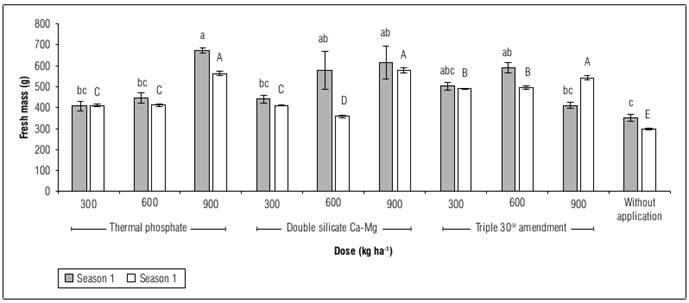
Figure 1. Fresh mass of potato plants 'Diacol Capiro', under the application of increasing doses of three fertilizer amendments in two production cycles. Means with different lowercase letters (season 1, winter season) and uppercase letters (season 2, dry season) indicate significant differences according to Tukey's test (P≤0.05), bars indicate standard error (n=4).
Fresh mass stands as a robust estimator of plant volume due to water constituting a primary component in nearly all organs and tissues (Di Benedetto and Tognetti, 2016). This metric serves as a valuable indicator of plant growth, as it offers insights into both the effective utilization of nutrients and the heightened efficiency of physiological and metabolic processes on the cellular scale. These factors collectively contribute to the expansion of the volume of distinct plant tissues and organs (Galindo-López et al., 2018).
The application of fertilizer amendments constitutes the most effective way to correct acidity problems in soils with low pH (Calva and Espinosa, 2017), this practice stimulates plant growth by reducing the toxicity generated by high contents of Al, Fe, and Mn and increasing the availability of nutrients (Espinosa and Molina, 1999) and generating a contribution of elements such as P, Ca, Mg, S, and Si (Galindo-López et al., 2018; Pinzón et al., 2017; Quintana et al., 2017).
Significant differences (P≤0.05) in dry mass accumulation were observed across treatments. In both evaluation cycles, the highest total dry mass accumulation occurred in treatments involving the application of 900 kg ha-1 of Triple 30® amendment, with values of 67.7±2.7 and 61.3±1.56 g, for season 1 and 2 respectively, similar results in two season indicate that 'Diacol Capiro' has greater plasticity under contrasting climatic conditions (Castellanos et al., 2022). Similarly, the treatment with 900 kg ha-1 of double silicate of calcium and magnesium exhibited substantial dry mass accumulation, yielding values of 68.0±2.90 (season 1) and 54.8±0.92 g (season 2). Notably, these two treatments did not exhibit statistically significant differences between them. In comparison, the control treatment displayed the lowest total dry mass accumulation, registering values of 40.1±1.71 and 39.3±0.96, for cycle 1 and 2 respectively (Fig. 2).
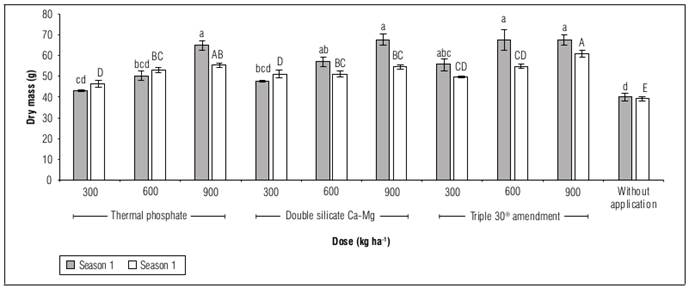
Figure 2. Dry mass of potato plants 'Diacol Capiro', under the application of increasing doses of three fertilizer amendments in two production cycles. Means with different lowercase letters (season 1, winter season) and uppercase letters (season 2, dry season) indicate significant differences according to Tukey's test (P≤0.05), bars indicate standard error (n=4).
It is reported that the increase in dry mass may be possible because supplemental levels of soluble Si improve the content of the enzyme ribulose 1,5-bisphosphate carboxylase-oxygenase (RuBisCO) in leaf tissue, which is responsible for regulating CO2 metabolism and promoting its more efficient use by plants (Epstein, 2009; Orzol et al., 2023), so, Si can improve canopy photosynthesis (Rengel et al., 2023). Even, Si it can mitigate possible effects of the water stress (Araujo et al., 2019), this effect can be beneficial in season 2. In beans, the application of magnesium silicate increased biomass, due to the improvement in nutritional dynamics that allowed the absorption of nutrients such as P, Ca, Mg, and Si, which generated an increase in the photosynthetic rate (Pinzón et al., 2017).
According to Fernandes et al. (2010), the accumulation of dry matter in plants during their development is primarily attributed to photosynthetic activity, complemented by nutrient uptake. Additionally, Di Benedetto and Tognetti (2016) affirm that dry weight serves as a robust estimator of total plant carbon content, facilitating the analysis of crucial aspects of physiological processes conducted by plants. In line with this, Lerma-Lasso et al. (2020) propose that the application of agricultural lime plays a role in Al3+ immobilization, leading to increased cation exchange capacity, along with improved phosphate availability. This positive effect allows for enhanced dry mass accumulation and the augmentation of other growth variables in forage species.
The accumulation of dry and fresh mass was positively affected by the application of the treatments. A similar behavior was observed in biomass accumulation in the two cycles. The application of increasing doses of amendments generated a greater accumulation of biomass in both the root and aerial parts. The double silicate of calcium and magnesium and triple 30® amendment generated a greater accumulation of mass in the evaluated organs, compared to the control treatment in which the accumulation showed the lowest values (Tab. 2).
Table 2. Mass accumulation in potato plants 'Diacol Capiro', under the application of increasing doses of three fertilizer amendments in two production seasons.
| Treatment | Dose (kg ha-1) | Season 1 | Season 2 | ||||||
|---|---|---|---|---|---|---|---|---|---|
| Fresh mass (g) | Dry mass (g) | Fresh mass (g) | Dry mass (g) | ||||||
| Root | Aerial part* | Root | Aerial part* | Root | Aerial part* | Root | Aerial part* | ||
| Thermal phosphate | 300 | 36.0 bc | 371.1 bc | 8.4 cd | 34.9 cd | 34.5 e | 379.3 ab | 5.6 c | 40.8 bc |
| 600 | 41.8 abc | 402.6 bc | 8.7 bc | 41.9 bcd | 35.6 de | 304.0 d | 5.0 c | 48.3 a | |
| 900 | 45.3 ab | 625.3 a | 9.5 bc | 55.6 a | 41.1 cde | 391.7 a | 6.7 c | 48.8 a | |
| Double silicate Ca and Mg | 300 | 35.2 bc | 403.7 bc | 7.0 de | 40.8 bcd | 42.4 cde | 299.4 d | 11.0 b | 40.2 bc |
| 600 | 42.9 abc | 532.9 ab | 8.7 bc | 48.5 ab | 46.0 bc | 294.6 d | 11.5 b | 39.8 bc | |
| 900 | 47.8 ab | 566.7 ab | 10.1 ab | 57.9 a | 59.7 a | 384.1 a | 14.3 a | 40.5 bc | |
| Triple 30® Amendment | 300 | 48.6 ab | 453.0 abc | 8.5 cd | 47.4 abc | 32.3 e | 359.2 bc | 12.4 ab | 37.4 bc |
| 600 | 55.4 a | 534.0 ab | 11.6 a | 56.3 a | 45.8 bcd | 339.8 c | 11.7 ab | 43.2 ab | |
| 900 | 48.3 ab | 361.2 bc | 9.5 bc | 58.1 a | 54.4 ab | 342.0 c | 12.0 ab | 49.3 a | |
| Without application | 0 | 27.9 c | 321.4 c | 6.4 e | 33.7 d | 21.5 f | 260.8 e | 5.0 c | 34.3 c |
*Aerial part: shoot and leaves. Season 1: winter season; season 2: dry season. Means with different letters indicate significant differences according to Tukey's test (P≤0.05).
In young plants, leaves exhibit substantial water content attributable to their essential roles in gas exchange, photosynthesis, and nutrient/mineral transport. Subsequently, stems follow suit, constituting a significant portion of the plant's fresh mass (Bäzinger et al., 1997). The distribution of dry matter among various plant organs holds pivotal importance in crop production. This distribution represents the outcome of a well-ordered sequence of metabolic and transport processes governing assimilate flow through a source/sink system (Barrientos et al., 2015).
The soils used for potato crop production in Colombia are characterized by being acidic, rich in organic matter, poor in Ca, Mg, and high in Al, but with a favorable relationship between liming or chemical improvement of soils and the utilization of some of the nutrients, especially P (Ríos et al., 2010). One of the limitations of potato crops in Colombia is the complexity of planting, since it requires multiple adjustments to solve the acidity and nutrient poverty of soils (González, 2017).
A substantial increase in leaf area was observed through the application of fertilizer amendment at escalating doses during both evaluation cycles. Notably, treatments involving the application of 900 kg ha-1 of double calcium and magnesium silicate exhibited noteworthy leaf area values of 9,180.5±175.6 and 9,300.5±127.7 cm2, for cycle 1 and 2 respectively. Similarly, the treatment involving 900 kg ha-1 of triple 30® amendment demonstrated significant leaf area expansion, yielding values of 9,198.7±116.5 cm2 (season 1) and 9,004.5±130.4 cm2 (season 2), respectively. Notably, these two treatments did not show statistically significant differences between them. In contrast, the control treatment exhibited lower leaf area accumulation, registering values for cycle 1 and 2 of 4,026.4±133.4 and 41,13.5±75.4 cm2, respectively (Fig. 3).
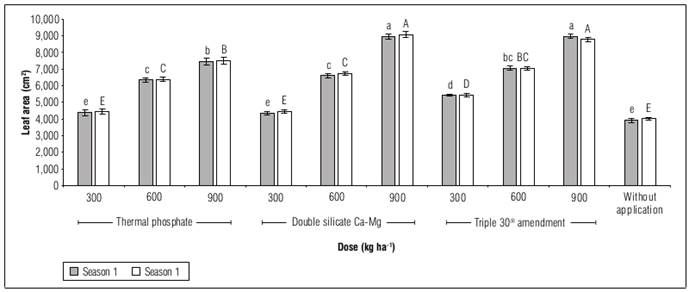
Figure 3. Leaf area of potato plants 'Diacol Capiro', under the application of increasing doses of three fertilizer amendments in two production cycles. Means with different lowercase letters (season 1, winter season) and uppercase letters (season 2, dry season) indicate significant differences according to Tukey’s test (P≤0.05), bars indicate standard error (n=4).
Leaf area is a fundamental variable to study crop development and growth, it defines the capacity of the plant canopy to intercept photosynthetically active radiation (PAR) (Warnock et al., 2006). Furthermore, it plays a crucial role in estimating water and nutritional requirements, bioenergetic efficiency, and the interception of solar radiation, associated with photosynthesis and the transpiration process. These aspects are closely associated with biomass accumulation and overall productivity (Mendoza-Pérez et al., 2017; Lucena et al., 2018). The greater the leaf area, the greater the photosynthetic activity tends to be (Jadoski et al., 2012). Consequently, leaf area can be used to estimate the yield potential of a genotype, as well as the phenological stage of the crop (Silva et al., 2022).
According to Jadoski et al. (2012), high leaf area values may be related to a greater interception of solar radiation, increasing plant growth, and tuber yield. An improved plant structure along with an optimal spatial distribution of leaf area contributes to superior photosynthetic efficiency (Silva et al., 2020). Moreover, Pinzón et al. (2017) observed a positive influence and an increase in leaf area, dry biomass, and yield through the application of increasing doses of magnesium silicate in bean crops, under similar conditions to those in the current investigation.
Leaf thickness
Significant differences (P≤0.05) in leaf thickness were observed between treatments during the second evaluation cycle. Application of 600 and 900 kg ha-1 of double silicate of calcium and magnesium increased leaf thickness to 0.56±0.03 and 0.55±0.06 mm, respectively, compared to the control treatment with a thickness of 0.3±0.04 mm (Fig. 4).
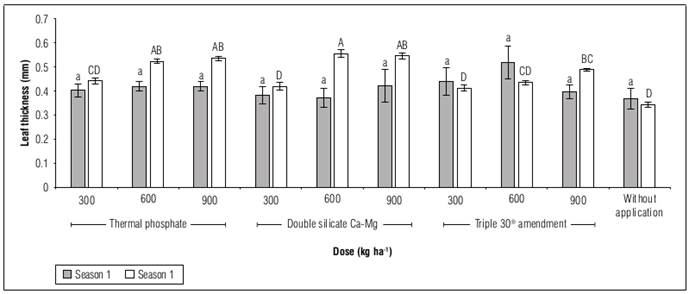
Figure 4. Leaf thickness in potato plants ‘Diacol Capiro’, under the application of increasing doses of three fertilizer amendments in two production cycles. Means with different lowercase letters (season 1, winter season) and uppercase letters (season 2, dry season) indicate significant differences according to Tukey's test (P≤0.05), bars indicate standard error (n=4).
In this study, fertilizer amendments with 12-15% silicon were used, resulting in increased leaf thickness. As Epstein (2009) and Orzol et al. (2023) indicate, silicon absorbed by roots is transferred to aerial plant parts via xylematic current, with leaves being the primary destination due to their high stomata count and transpirational force. According to Marafon and Endres (2013), silicon deposition in leaves leads to the formation of a silicon-cellulose membrane associated with pectin and calcium ions, which is consistent with the study's findings of increased leaf thickness due to the application of silicate fertilizer amendments. This possible greater accumulation of silicon in leaves can mean better response to condition of stresses (Orzol et al., 2023) to potato crop evaluated. In addition, Potato plants with greater leaf thickness can better tolerate water deficit conditions, which can occur at the dry season of cycle 2. The importance of a larger leaf thickness in more tolerant of the hydric deficit has been reported (Wiangwiset et al., 2023).
Yield
Statistically significant differences were found when analyzing this variable (P≤0.05). The treatment with the highest yield in the first evaluation cycle was a double calcium and magnesium silicate treatment (61.8±4.1 t ha-1), while the best treatment in the second cycle was triple 30® amendment (60.9±2.3 t ha-1). The control treatment had the lowest yield in both cycles (42.3±4.15 t ha-1 (season 1) and 38.9±1.9 t ha-1(season 2)) (Fig. 5).
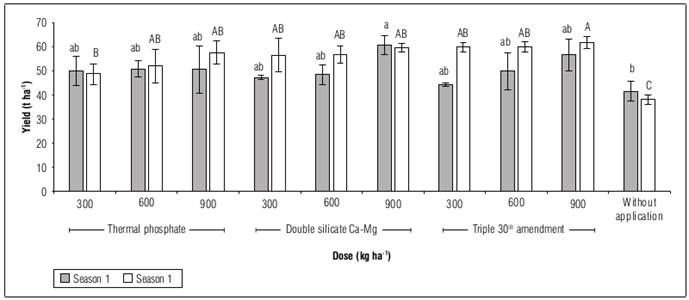
Figure 5. Yield of potato plants variety 'Diacol Capiro', under the application of increasing doses of three fertilizer amendments in two production cycles. Means with different lowercase letters (season 1, winter season) and uppercase letters (season 2, dry season) indicate significant differences according to Tukey's test (P≤0.05), bars indicate standard error (n=4).
The application of fertilizers with a corrective effect generates an adequate nutritional balance, improves the supply of essential nutrients, and enhances the physiological processes of the plant, resulting in better yields. Regarding the aforementioned, Aguilar-Acuña et al. (2003), indicate that, by generating a liming process, followed by phosphorus fertilization, an increase in yield was generated in the potato crop. Fernandes et al. (2017) indicated that by improving P availability, plant growth and tuber diameter increased.
It can be observed that the application of unconventional sources such as fertilizer amendments generated an increase in growth variables such as the dry and fresh mass of root and aerial part and leaf area. Consequently, this improved the physiological performance of the plant leading to a higher yield when compared to the application of conventional fertilization sources. With the application of thermal phosphate and/or Ca and Mg silicates, a positive effect on yield increase has been observed in crops such as common bean (Pinzón et al., 2017; Quintana et al., 2017), strawberry (Galindo-López et al., 2018), onion (Pinzón et al., 2019) and potato (Torres-Hernández et al., 2020).
CONCLUSION
The application of silicate fertilizer amendments generated a positive effect on potato plant growth represented in a greater accumulation of biomass, leaf thickness, and leaf area. Furthermore, the plants maintained an adequate physiological status, among the treatments, the application of the double calcium and magnesium silicate was the one that generated a better response. A positive reaction was evidenced with the progressive application of increasing doses of silicate fertilizer amendments with macronutrients such as phosphorus, calcium, and magnesium in their composition, accompanied by a beneficial element such as silicon, with a differential response compared to plants with nutrition-based only on NPK compound fertilizers.















